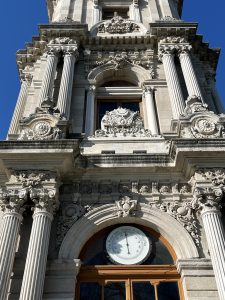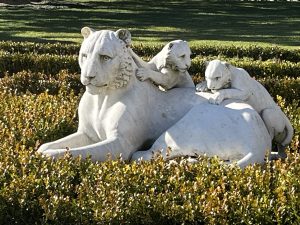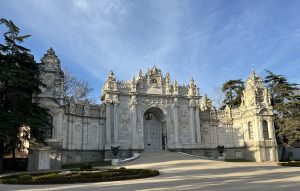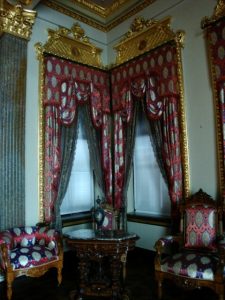Closed Mondays. Admission 2024: TL1,050 (TL150 for Turks). Photography not allowed. Audio-guides available and worth having. Combination ticket options: https://www.millisaraylar.gov.tr/Lokasyon/3/Dolmabahce-Palace

By the mid-1850s the sultans had decided that the only way to safeguard the future of the Ottoman Empire was to westernise it. As part of that thinking they decided to abandon the old Topkapı Sarayı on Sarayburnu in favour of a brand-new Western-style palace on the side of the Bosphorus traditionally associated with Westerners. As architects, they chose Garabet and Nikoğos Balayan, two members of an Ottoman Armenian family of architects who were already making a mark on the city. Work began in 1843 and was completed in 1856 during the reign of Sultan Abdülmecid I. Afterwards the palace became home to sultans Abdülaziz, Murad V, Abdülhamid II, Mehmed V Reşad and Mehmed VI Vahideddin as well as to the last caliph, Abdülmecid Efendi. More surprisingly, Atatürk spent four years in the palace, eventually dying here, while his successor, İsmet İnönü, lived here until 1949. The palace became a museum in 1984.
For Western visitors Dolmabahçe looks more like their idea of a palace than Topkapı inasmuch as it is one solid building rather than a collection of kiosks set around courtyards. In all it has 285 rooms and although only a selection are open to the public a visit can seem rather like a trip to İKEA as you march along corridors with side rooms either behind closed doors or roped off so you can only glimpse their interiors from a distance. The palace was built in a baroque style which works well externally. Inside, however, the gilt and the glass and the endless elaborate decoration rapidly becomes wearing.
Today’s visitors approach not from the main water-facing entrance as the sultan would have done but from the side entrance into the Selamlık or administrative part of the palace. They do so via the Administrative Gate and across landscaped gardens which contain several sculptures of lions, and lionesses and their cubs which were commissioned after Sultan Abdülaziz’s train trip to Europe in 1864. On the roadside of the garden stands the grand curved Salutation Gate which is always visible as you sit in traffic jams on the road outside.
Steps lead up to the side entrance and into a reception hall where visitors would wait to be received. Beside it the grand vizier would have had his office, while beyond it the more important officials had sea-facing offices while MPs looked over the garden. Here, too, was a room where all the valuable gifts the sultan planned to send to Mecca and Medina at the time of the annual Haj would be stored – Stephano Ussi’s huge painting, The Sürre Procession, depicts the caravan on its way in 1873 (in 2024 it did not seem to be on display). Beyond these offices there is a grand entrance hall where the sultan could leave by caique along the Bosphorus at the front or by carriage at the back.
In 2024 the magnificent crystal staircase leading up to the hall used for public receptions was under wraps for restoration. The marked route continues to the Red Room, another reception hall where foreign ambassadors would wait to be admitted to the sultan’s presence. It then brings you to the Privy Chamber which was used for banquets and wedding parties as well as for celebrations during Ramazan. You will then pass Abdülmecid Efendi’s private library with its shelves of dusty volumes and a small music room. Shortly afterwards you’ll come to the delightful private hamam where the sultan would bathe surrounded by walls of alabaster.
For most people by far the most impressive and memorable room will be the Ceremonial Hall with its concealed internal dome and a chandelier of Bohemian glass weighing 4.5 tons that was a gift from Queen Victoria. Given that it took three months to install it it’s perhaps not surprising that it looks in need of a thorough spring-cleaning. The room was used during Ramazan when a 250kg golden thrown would be brought over from Topkapı for the duration. Amongst other important events to take place here were the coronation of Sultan Murad V, the first meeting of the Ottoman Parliament in 1877 and Atatürk’s first speech as president of the new Turkish Republic.
Although it is structurally part of the same building, the Harem (private or family) part of the palace must now be entered from a separate entrance to the rear. Many people will find the long succession of formal rooms here rather dull, although it’s still worth coming in to see the one in which Atatürk died at 9.05 on 10 November 1938, a Turkish flag tucked around his bed, the clock on the table stopped at the time of his death. His body lay in state in the Ceremonial Hall for three days before being conveyed to Ankara to be laid to rest in the Anıtkabir. Some will also be interested in the Sünnet Odası (Circumcision Room) where imperial sons rested and received well-wishers after their operation.
A separate building beside the palace was home to the crown princes and now contains a fine painting and sculpture museum with many lovely seascapes by the Crimean artist, Ivan Konstantinovic Ayvazovski (1817-1900). It sometimes closes earlier than the main palace so be sure to check if you want to see the pictures.
 Not apparently open in 2024, the Camlı Köşk on the outer wall of the palace is a delightful small pavilion where the sultan could escape if he needed space to himself. It has a magnificent ceiling painted with images of docile-looking wild animals, and a piano with crystal legs. The aviary also appears to be closed for the time being.
Not apparently open in 2024, the Camlı Köşk on the outer wall of the palace is a delightful small pavilion where the sultan could escape if he needed space to himself. It has a magnificent ceiling painted with images of docile-looking wild animals, and a piano with crystal legs. The aviary also appears to be closed for the time being.
Eating
The Harem Cafe in the grounds beside the entrance to the Harem offers light sustenance. You can also grab a bite or just a drink in the Saat Kule (Clock Tower) Cafe beside the Bosphorus – this is accessible to anyone, not just ticket-holders.
Transport
The nearest tram stop is Kabataş which is on a direct line from Sultanahmet. From Taksim you can easily walk downhill to the palace along Gümüşsuyu Caddesi or take the funicular down to Kabataş if you prefer. There are also frequent buses to Dolmabahçe from Beşiktaş.



